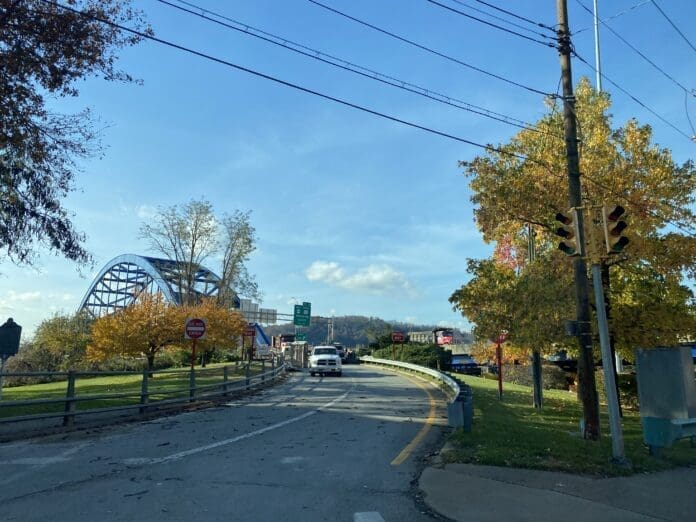Two years down and only one more to go for the projects along Interstate 70 in Ohio County, according to WVDOH District 6 Engineer Tony Clark, but there is much more construction expected to take place in downtown Wheeling through at least 2024.
That is because two long-awaited projects will finally take place, including the $25 million streetscape project along Main and Market streets and a $20 million rehabilitation project to the Wheeling Suspension Bridge that was initially scheduled more than eight years ago.
“The streetscape that will begin next year is not the same project that it started out to be six years ago, and there have been a lot of issues with the Wheeling Suspension Bridge since the rehab and beautification project was first mentioned,” Clark explained. “Motorcoaches traveling over a suspension bridge that is older than 150 years is a worrisome scenario, but that’s what has happened twice in the past few years.
“As far as Interstate 70 is concerned, the project has progressed very well since it started,” he said. “Deadlines have been met by the general contractor, and despite the pandemic, there really haven’t been many delays in any areas of the work.”

The Flow Returns
At the time the $214 million project was awarded to Swank Construction, Ohio County Sheriff Tom Howard had his doubts because of ambitious deadlines concerning the bridges east of Wheeling Tunnel. According to the timelines released by the DOH, the westbound and eastbound “Fulton” spans were to be demolished and replaced in fewer than eight months.
“I’ll be the first person to admit it,” Howard said.“I really thought this whole thing was destined for disaster because I have never seen a bridge of that size be constructed so quickly. That’s why now I’ll be the first to admit I was wrong. Those crews have done an outstanding job.
“It’s been fun for me to watch because of the way they do things these days,” the sheriff said. “And for everything to be on time with Covid-19 in the air has been amazing.”

Several months’ worth of work remains with the Fort Henry Bridge and on the overpasses near the 5-mile marker in Elm Grove, and that means fewer barrels will be placed along the 14.5 miles of I-70 in the state of West Virginia.
“The completion date for everything involved with the Interstate 70 projects is late October 2022,” Clark confirmed. “But what I can say is that there’s not going to be the same volume of work next year that we have seen since this project started about two years ago. The bigger projects have been completed, so most of the work that will be performed next year will involve painting and steel repairs.
“The Interstate 70 project as a whole is definitely the largest project, we have had in District 6 for a very long time,” the district engineer said. “I believe when they were building I-470 was the last time the people in the Wheeling area have seen anything close to what has taken place the last couple of years. Before that, the actual building of Interstate 70 back in the 1950s was probably the largest.”

Unpleasant Surprises
W.Va. Gov. Jim Justice trashed the first set of bids that were collected and opened in August 2018, and then he instructed officials with the state Department of Transportation to diminish the overall scope of the extensive project. After a one-year delay, Swank was awarded the project with monies generated by the governor’s “Roads to Prosperity” initiative that was approved by Mountain State voters in 2017.
Although the approved bid was for $214 million for 26 ramps and bridges to be repaired or replaced, the final price tag will not be calculated until completion. It is likely, Clark said, the final cost will be more than projected because of change orders and encountered surprises.
“The only things I would classify as surprise problems have involved the amount of deterioration that had taken place that the inspectors were not able to capture when scoping the project in the very beginning,” the district engineer explained. “That’s because you really don’t know how bad something is until you can get it completely exposed, and there were cases where there was much more work that needed done that was not expected.
“When it comes to the steel, the inspectors could see rust, but there’s really no way of knowing exactly how bad it is until you can get in there and do some sandblasting,” Clark added. “Maybe I should refer to those situations as surprises, but there were occasions when some of the steel needed completely replaced instead of just repaired.”


